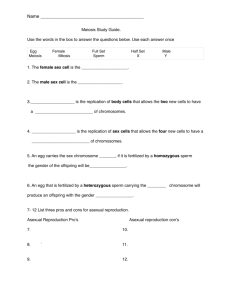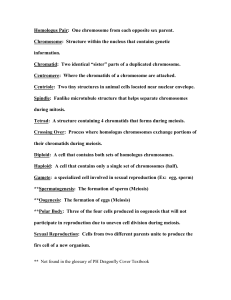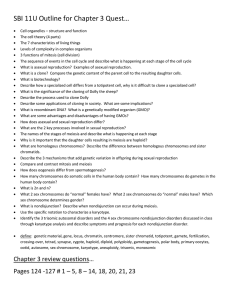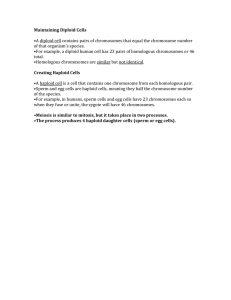Chapter 11 Review sheet: Meiosis and Sexual Reproduction
advertisement
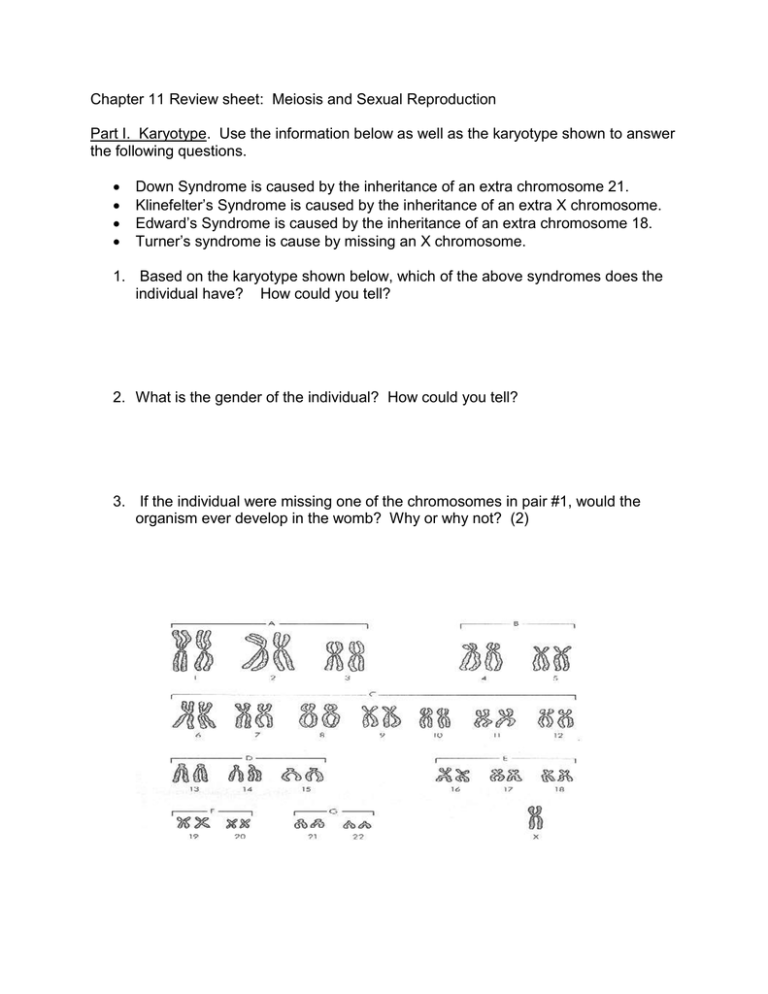
Chapter 11 Review sheet: Meiosis and Sexual Reproduction Part I. Karyotype. Use the information below as well as the karyotype shown to answer the following questions. Down Syndrome is caused by the inheritance of an extra chromosome 21. Klinefelter’s Syndrome is caused by the inheritance of an extra X chromosome. Edward’s Syndrome is caused by the inheritance of an extra chromosome 18. Turner’s syndrome is cause by missing an X chromosome. 1. Based on the karyotype shown below, which of the above syndromes does the individual have? How could you tell? 2. What is the gender of the individual? How could you tell? 3. If the individual were missing one of the chromosomes in pair #1, would the organism ever develop in the womb? Why or why not? (2) Part II. Sexual vs. asexual reproduction. Fill in the chart below comparing sexual and asexual reproduction. Sexual reproduction Number of parents How offspring compare to the parents Examples Union between _______ and __________ cells Asexual reproduction 1. Binary fission in bacteria 2. ___________________ in worms Part III. Fill in the blank. Complete each sentence below. 3. There are _______ chromosomes in egg or sperm cells. 4. There are _______ chromosomes in body cells, such as blood, skin, bone, and hair. 5. Sometimes, chromosomes don’t separate properly during meiosis. If a cell has 3 copies of a chromosome rather than 2, it is known as a _______________. 6. If a cell has 1 copy of a chromosome rather than 2, it is known as a _______________. 7. ____________ chromosomes determine your gender. 8. If you inherit 2 X chromosomes, you will be a _________. 9. If you inherit an X and a Y chromosome, you will be a _________. 10. The female sex cell is known as a(n) ____________. 11. The male sex cell is known as ______________. 12. The process that fuses the male sex cell with the female sex cell is called ________________________. 13. When a sperm and an egg fuse, the resulting cell is called a _______________. You all started out life as this! 14. _____________________ chromosomes have the same genes. 15. ____________________ are the 44 chromosomes that have nothing to do with your gender. 16. __________________ cells is another name for body cells, such as hair, skin, bone, and blood. 17. __________________ is the process that produces eggs and sperm, which have half the number of chromosomes of their parent cells. 18. In males, meiosis results in ______ haploid sperm cells. 19. In females, meiosis results in ______ haploid egg cell, and 2-3 ________ __________ that die. 20. The process of making sperm is ___________________________. 21. The process of making eggs is _____________________. 22. __________________ produces an organism that is genetically identical to the parent. Part IV. Short answer. 23. Name 2 advantages of reproducing asexually. 24. Why would organisms who reproduce sexually have an advantage in terms of their survival if there were changes to the environment? Part V. True or false. Read each statement below, and identify whether it is true or false. ___ 25. You started out life as one cell, which was formed when the sperm cell fertilized the egg cell. ___ 26. You once looked no different from any other vertebrate at their early stages of development. ___ 27. You had gills early in development. ___ 28. You had a tail early in development, which eventually became your backbone.

